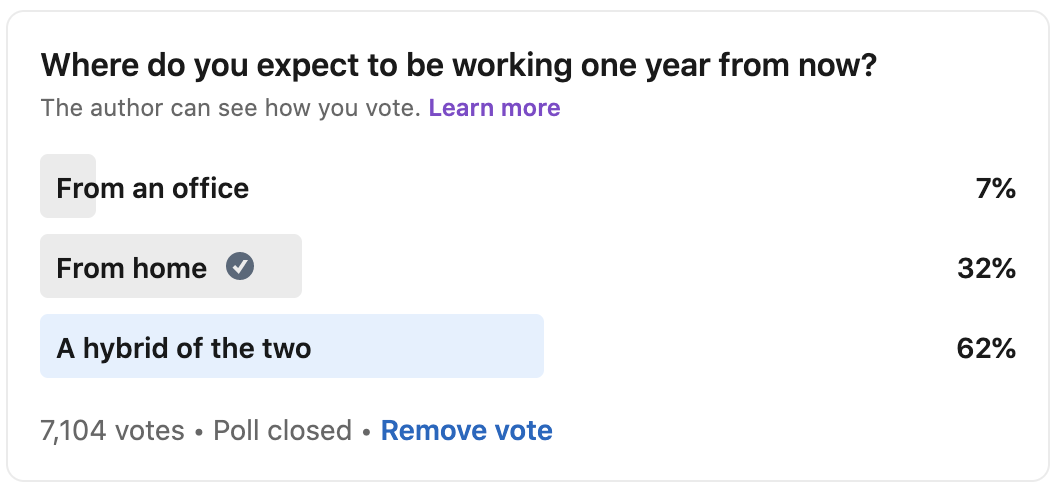5-second summary
- 61 percent of executives are keen to completely reimagine how work gets done at their companies
- Hybrid work models that combine at-home and in-office work offer some promising solutions, but it’ll be easier to get them wrong than to get them right.
- For hybrid to succeed, companies need to strengthen communications channels, re-evaluate how they measure performance, and take a flexible approach that considers the needs and circumstances of all employees individually.
Some suggest that the pandemic is a storm everyone experiences equally. That is utter B.S. Yes, the storm has hit the whole world, but everyone is in a different boat. Some are in super yachts. Some are on inflatable rafts. Some are in their boats alone. Others have an entire family in there. And all this, during the forced experiment of working from whatever boat we find ourselves in.
The past year has shaken up everything and everyone – including CEOs and senior leaders who were already trying to transform the way their companies worked back in the Before Times™. Now, there’s a whale-sized appetite among executives to make dramatic changes as part of transitioning out of remote-only mode. But will reimagined workplaces be the rising tide that lifts all ships or the Leviathan that swallows us whole?
The case for a hybrid work model
Like most other aspects of the pandemic, working from home hasn’t been equal for everyone. In fact, for many, it’s been a year of sleeping at work, not working from home. A study from last fall showed that one in four U.S. women was thinking of leaving the workforce. Many cited the losing game of trying to be an engaged employee and an engaged parent simultaneously, saying it’s just not worth the stress of failing at both. And the fun doesn’t stop there.
Not only has the pandemic affected us differently, but we also have different preferences as to what a reimagined workplace looks like. According to a poll we conducted on LinkedIn, 62 percent of office workers want the flexibility to mix in-office and at-home work – what is often called a hybrid work model. 32 percent preferred to work from home and seven percent wanted to return to the office. Research from Slack also found similar gaps in employee preferences.

These unequal experiences and preferences come into play when we start talking about building balanced teams, and balanced teams matter (even outside the fairness and equity factor). Companies with a diverse workforce outperform their more homogenous competitors. They generate 130 percent higher cash flow per employee. They bring in 19 percent more revenue from innovation. They adapt 80 percent faster to address challenges or pursue opportunities. We cannot build these kinds of companies if we don’t create a new normal where women, people of color, people with disabilities, and people from different generations can thrive. Full stop.
Deloitte asked over 3,500 senior leaders what they plan to do about it, and 61 percent said they’re focused on reimagining work. Not optimizing it, not making a few tweaks here and there as they’d been saying in previous years. No: they are throwing everything into the air and fully reimagining the outcomes they want, and the combinations of people and technology it will take to achieve them.
This. 👏 Is. 👏 Huge. 👏
How hybrid could go wrong (and what to try instead)
Finding that new, yet more familiar, version of “normal” won’t happen automatically. Most companies are planning for some kind of hybrid work model that combines in-office and remote work. Many of them are sailing into uncharted waters. (Here there be dragons! 🐉)) And any company runs the risk of designing its hybrid work model based solely on what the majority wants, which isn’t necessarily inclusive and will have negative effects in the long term.
With that in mind, we stepped through a thought exercise called a “premortem” – much like a post-mortem, except nothing has actually died yet. Because now is the time to imagine all the ways hybrid work models could fail. Now, while we can still do something about it.
Failure #1: allow collaboration to favor the co-located
Before the pandemic, most teams that had some people in-office and some remote, creating a two-tiered system when it came to synchronous collaboration (a.k.a., meetings). People in the room tended to dominate, while people dialing in struggled to express their ideas. We need to be more inclusive than that.
- 💡Here’s an idea… Instead of always sharing info and ideas in real-time, let’s embrace asynchronous collaboration. If I put my idea on a page in Confluence and share that with my team, everyone has an equal chance to take it in, mull it over, and help improve on it. Then we can meet briefly to discuss live.
Failure #2: allow flexibility on location but not on schedules
There’s no real reason to think that juggling work and personal schedules will magically become easy this year (or next year, or the year after). Caregivers still have elderly parents to make breakfast for and kids to pick up from school. Anyone struggling with mental health or chronic physical issues still has regular appointments to fit in. Not to mention the “pandemic puppies” that need to be walked. These kinds of things have always been a challenge with coming into the office.
But working from home isn’t a solution in and of itself. Atlassian surveyed 5,000 knowledge workers in June 2020, many of whom reported that trying to be a teammate and a caregiver at the same time made them feel like they were crap at both.
- 💡Here’s an idea… Instead of requiring teams to work the traditional 9-to-5, let’s allow for flexible schedules. Designate times for synchronous collaboration (meetings, etc.) that serve as anchor points for the whole team. Aside from that, the rest of the day is theirs to schedule as they see fit. For instance, at Atlassian, we’ve determined that teams need 4 hours of overlap in a given workday for collaboration.
Failure #3: only look at employees’ needs in the aggregate
People’s preferences around where they work are based on different factors. Maybe you get too distracted at home, or too lonely, or your kitchen table makes a lousy workstation, and your heart cries out for the office. Maybe you have a health condition that makes office life tricky, or you love the focus you can achieve by working at home, or you want to ditch your commute.
- 💡Here’s an idea… Instead of assuming that everyone wants to be in (or out of) the office for the same reasons, let’s have conversations with our teams to understand what’s behind these preferences so we can support each other better.
Failure #4: ignore the value of relationships
Nobody is the same person they were a year ago. Plus, team membership has changed. Most companies now have employees who have never been to a company office or met their teammates in person. If we don’t make a point to build strong relationships, work will start to feel transactional, degrading both morale and productivity. (For some, that’s already happening.)
- 💡Here’s an idea… Instead of assuming that we can just pick up where we left off, let’s create moments to reconnect on a personal level: team dinners, company picnics, days where everyone comes into the office with some time for casual hanging-out baked in.
Failure #5: “lift and shift” your existing practices into a new environment
When we went remote a year ago, we learned the folly of assuming our office-based practices would be just as effective. Similarly, it would be folly to assume we can simply teleport our remote practices into a hybrid model.
- 💡Here’s an idea… Instead of copying and pasting our remote-friendly practices into a hybrid model, let’s audit and evaluate our meetings, workflows, rituals, and individual responsibilities to adjust them for whatever version of hybrid we’re adopting. Then rinse and repeat on a regular basis so we continue optimizing.
Failure #6: allow performance reviews to create a two-tier system
Performance assessments have traditionally been rooted in presenteeism: I can see Maria here, in the office, at her desk; therefore I form a baseline impression of her as a dedicated employee. Raj, however, works at home most days. He might be nose-to-the-grindstone, but my default is to suspect he’s slacking off because I have no visual confirmation that he’s working.
So guess what? Maria will be evaluated higher than Raj, regardless of the results they achieve, because humans have a cognitive bias around preferring that which we can see. This, of course, is utter bollocks. Thankfully, we mostly unlearned that during a year of lockdown.
- 💡Here’s an idea… Instead of slipping back into old patterns, let’s base performance assessments on outcomes. Not output of effort, outcomes. How has each person contributed to the company’s big goals? How have they demonstrated the right values and behaviors, and made their team more effective? If they’ve excelled in those areas, it shouldn’t matter where (or when) they work.
Failure #7: treat communication as a one-way street
Our habit of broadcasting information en masse has become more entrenched over the past year. We used to broadcast in person during status meetings and town halls. Now we’re doing it through email, chat, and video conferencing. And we’re using that technology to measure the wrong things. We’re measuring how many people opened the email or tuned into a virtual town hall, which misses the point entirely. Communication isn’t about what you’ve said, it’s about what the other person has heard and understood.
- 💡Here’s an idea… Instead of treating internal communications as a one-way street, let’s check in with people to make sure messages are having the desired effect. This doesn’t necessarily have to be a formal org-wide survey. A spot-check with a handful of people now and then might be sufficient.
We’re gonna need a little humility
Hybrid work models will fail if leaders act like they can predict the future. If they don’t continuously assess and adapt. The best leaders right now are those who are empathetic and courageous enough to throw their hands up and say, “I don’t know what’s going to happen. But here’s what I think we should try. Come along with me and let’s be open with each other about what’s working and what’s not.”
That’s a massively authentic (and risky) thing to say. But it’s what we need for the foreseeable future – and probably beyond.
By adapting the “where” of work, we can build more congruent links between technology, practices, and people. But an iteration on the old way isn’t going to cut it. We need a full reimagining. We need to unlearn a bunch of cruft from the past year, and even more of the cruft we carry with us from the Before Times. We don’t know how we get there, but we know it’s important.












































